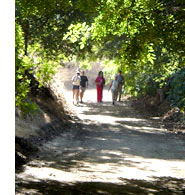 Great Question. Environmental Impact Reports (EIRs) are definitely the way for your voice to be heard. As you know, they are the primary way that the public has of understanding and assessing the potential environmental impacts of proposed development. But EIRs can be imposing and complicated documents. Click HERE for tips on how to make effective comments on an EIR document.
Great Question. Environmental Impact Reports (EIRs) are definitely the way for your voice to be heard. As you know, they are the primary way that the public has of understanding and assessing the potential environmental impacts of proposed development. But EIRs can be imposing and complicated documents. Click HERE for tips on how to make effective comments on an EIR document.
What are the most important goals the Hillside Open Space Education Coalition (HOSEC) hopes to accomplish?
HOSEC, a coalition of four cities and two community associations, was established to find ways to preserve and acquire strategic parcels of hillside open space threatened by development; to prevent unwanted impacts on existing traffic congestion, schools, community infrastructure, and runoff pollution, as well as to safeguard the Puente-Chino Hills Wildlife Corridor, an area of natural lands that stretches from the San Diego County line to the Whittier Narrows.
Why is it important to educate north Orange/Los Angeles County residents about the importance of open space?
HOSEC was actually formed in response to residents, who for years implored their elected officials to preserve the open space in and around their communities. Residents in these areas already value open space preservation. HOSEC's educational mission is to inform people how they can help work toward this goal.
Many people aren't aware of how influential their opinion can be when directed to the right people. Or even who the right people are. Additionally, it is important that the public understand that preserving these wildlife and open space corridors is possible. And though challenging, the goal is not only commendable, but also highly achievable if interested parties make their voices heard.
What can one person do?
The power of one voice can be very significant, as we've seen throughout American history. Preservation of the last remaining parcels of open space to complete the Puente-Chino Wildlife Corridor—will also be history making. Conversely, if we were to shrink from this responsibility, it would go down in history as an opportunity lost. If this land were developed, future generations would only be left to wonder at the lack of leadership and foresight that resulted in the loss of this valuable and irreplaceable land.
space to complete the Puente-Chino Wildlife Corridor—will also be history making. Conversely, if we were to shrink from this responsibility, it would go down in history as an opportunity lost. If this land were developed, future generations would only be left to wonder at the lack of leadership and foresight that resulted in the loss of this valuable and irreplaceable land.
HOSEC will coordinate the work of many visionary individuals who support this effort so that many voices can be heard as one loud voice. Watch here for news and updates on rallies and important meetings. Talk with your friends, family and neighbors.
Given the cost of land in Orange/Los Angeles County, how can any city or group of cities afford to purchase open space?
Federal and State grants, as well as funds from environmental groups may be available. Park bonds passed by the voters also have funds available. The work of one such local group is credited with raising millions to purchase land that is now known as Chino Hills State Park.
What would be lost if this area is developed? Does anyone really care about the Gnatcatcher?
In addition to the Gnatcatcher, the Puente-Chino Hills Wildlife Corridor contains more than 100 animal species including deer, coyotes, foxes, bobcats, hawks, owls, opossums, raccoons, gray squirrels quail, doves and butterflies. And the vegetation includes native California walnut woodlands, sycamore and oak forests, freshwater marsh, coastal sage scrub and grasses that contribute to the beauty of the open space area, and provide a vital refuge and foraging ground for many animal species.
Of course additional development, particularly of the magnitude being proposed, would also bring increased traffic to an already congested area. Traffic ranks high on the list of residents' concerns in all of the coalition cities. And increased development means greater urbanization and the resulting stormwater pollution that flow to the ocean.
Currently, what is the biggest threat to open space in this area?
 The most worrisome project facing HOSEC is the proposed development by Aera Energy, a subsidiary of Shell ExxonMobil. This project would be the largest single development ever proposed in the hills bordering Los Angeles and Orange counties. Aera owns 3,000 acres between Harbor Blvd. and the 57 freeway located in the middle of the Puente-Chino Hills Wildlife Corridor. They have proposed to develop 3600 houses, a golf course and three commercial centers on land that, if left undeveloped, would complete the Corridor and preserve this environmentally rich treasure forever.
The most worrisome project facing HOSEC is the proposed development by Aera Energy, a subsidiary of Shell ExxonMobil. This project would be the largest single development ever proposed in the hills bordering Los Angeles and Orange counties. Aera owns 3,000 acres between Harbor Blvd. and the 57 freeway located in the middle of the Puente-Chino Hills Wildlife Corridor. They have proposed to develop 3600 houses, a golf course and three commercial centers on land that, if left undeveloped, would complete the Corridor and preserve this environmentally rich treasure forever.